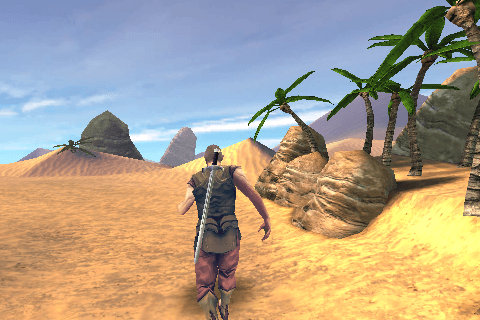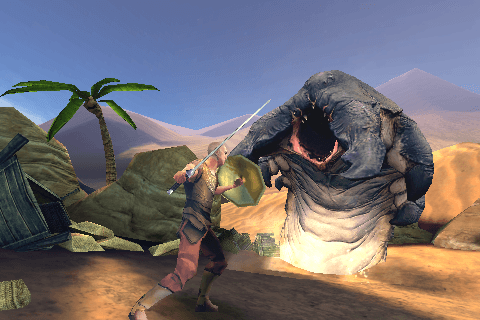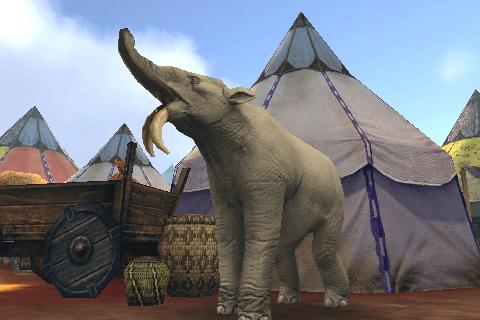- Wondering how to get Monopoly GO! free rolls? Well, you’ve come to the right place. In this guide, we provide you with a bunch of tips and tricks to get some free rolls for the hit new mobile game. We’ll …
Best Roblox Horror Games to Play Right Now – Updated Weekly
By Adele Wilson
Our Best Roblox Horror Games guide features the scariest and most creative experiences to play right now on the platform!The BEST Roblox Games of The Week – Games You Need To Play!
By Sho Roberts
Our feature shares our pick for the Best Roblox Games of the week! With our feature, we guarantee you'll find something new to play!All Grades in Type Soul – Each Race Explained
By Adele Wilson
Our All Grades in Type Soul guide lists every grade in the game for all races, including how to increase your grade quickly!
The Shadow Sun: An Interview with Ossian Studios Alan Miranda and Luke Scull
When screens of The Shadow Sun first surfaced last month, the iPhone gaming community was quickly taken aback. Looking to be an epic, sprawling, gorgeous RPG developed by Ossian Studios, The Shadow Sun was to be the debut iOS title from a team who was responsible for several Neverwinter Nights expansions. The game’s producer and Ossian Studios CEO Alan Miranda is even a veteran of what some would argue is the greatest western RPG development studio to date, BioWare. We recently had the chance to talk to Alan, as well as The Shadow Sun‘s lead designer Luke Scull, about their upcoming release.

When screens of The Shadow Sun first surfaced last month, the iPhone gaming community was quickly taken aback. Looking to be an epic, sprawling, gorgeous RPG developed by Ossian Studios, The Shadow Sun was to be the debut iOS title from a team who was responsible for several Neverwinter Nights expansions. The game’s producer and Ossian Studios CEO Alan Miranda is even a veteran of what some would argue is the greatest western RPG development studio to date, BioWare. We recently had the chance to talk to Alan, as well as The Shadow Sun‘s lead designer Luke Scull, about their upcoming release.
You were previously a producer at BioWare. Can you tell us a little about what you learned during your time there, and how that knowledge has helped shape The Shadow Sun?
Alan: I joined BioWare because I loved playing RPGs, especially Baldur’s Gate, and wanted to become involved in making them. This was back in 2000, when BioWare was shipping BG2, and I took on the role of producer on BG2: Throne of Bhaal (a dream come true for me). The creation of exciting, believable worlds to adventure in was what fascinated me the most back then, and continues to be a driving force behind the work I do on our RPGs at Ossian Studios.
Being part of the development team of Throne of Bhaal and later Neverwinter Nights, I became familiar with how great RPGs are made – things such as story and quest design, level design, combat encounters, art styles, and the huge role that audio plays in shaping the experience. But as a producer, I was the person tasked to make sure those things got done, and didn’t closely direct them (aside from audio). It wasn’t until after I had left BioWare and founded Ossian Studios, that I got the chance to apply that knowledge hands-on to our first game, NWN: Darkness over Daggerford (a former BioWare Premium Module), and our second game, NWN2: Mysteries of Westgate (for Atari).
As the producer on The Shadow Sun, I am doing what I did on BioWare games (and much more), but what is important to remember is that it’s not just what I learned from BioWare, but what our team learned as well. Many of them come from the Neverwinter Nights modding community, where they emulated BioWare’s games when creating their own high-quality Dungeons & Dragons mods (some of which were even contracted to be Premium Mods by BioWare). It is our team’s combined experience that will make The Shadow Sun a great RPG game.

Are you finding developing a western-style RPG on the iPhone challenging? What sort of design decisions did you make as a result of developing for this unique platform?
Luke: Designing a western RPG on the platform posed some unique challenges. One of those was marrying a detailed game system with a usable and fun control scheme. We wanted to give the PC (playable character) the same range of skills and the player the same level of world interaction that you would find in a high-budget PC RPG title. To achieve this, we implemented a context-sensitive Action button, which changes function depending on the current active object. For example, if the PC is opposite a friendly NPC, the Action button will initiate conversation. If they’re standing before a lever, the button will cause the PC to interact with the object. If enemies are present, the button launches an attack. To avoid possible overlaps between objects of varying types, our level and combat design needed to take this dynamic into account.
In terms of literary influence, you’ve mentioned the work of HP Lovecraft lending inspiration for the game’s fear of the unknown. What other influences helped you create the world of The Shadow Sun?
Luke: I wanted a setting that eschewed high fantasy in favour of a gritty, more realistic world. At the same time, full-on grimdark has now itself become something of a cliché. It’s important to focus on the fantastical aspect as well as the political scheming, moral ambiguity, and visceral combat that have become so popular in the wake of the success of A Song of Ice and Fire novels, as well as The Witcher and Dragon Age games. Hence, while the world of The Shadow Sun is a complex, brutal place full of vying groups, nations, and unimaginable horrors, it is also one full of incredible beauty that has been torn apart and reshaped through centuries of devastating magic and a continent-shattering cataclysm. I suppose the Malazan series most heavily influenced the world design, with the cities of present-day nations standing on the bones of those which preceded it. China Miéville’s Bas-Lag novels demonstrated how horror could be worked into a fantasy setting that pushes the creative envelope rather than falling back on the usual tropes: you won’t find any elves, dwarves, or orcs in The Shadow Sun setting. Most of the humanoid races in our world lack the merest shred of humanity. Finally, I’m a big fan of British author Joe Abercrombie and his cynical, darkly ironic humour. I wanted to work some of that into The Shadow Sun.
Alan: For me, The Shadow Sun would be a return to pre-Tolkien fantasy, one without elves, dwarves, etc. that have become so heavily embedded in almost all fantasy RPGs. By pre-Tolkien, I’m specifically referring to Robert E. Howard’s Conan stories. There is something I find particularly attractive about that “raw” fantasy: a world of early human civilizations, with all their ruthless politics and semi-barbarity, where those who wield magic are few, surrounded in mystique, and typically command greater influence. A world that is inhabited by savage creatures but remains for the most part unknown to humanity (it is the unknown that instills fear). This blends well with Luke’s inspirations, particularly the Malazan books, in which a primarily human world is embroiled in conflict.

Have you had a chance to check out the competition? What did you think of games like Ravensword and Xenome? Are there any lessons you’ve learned from competing titles that will make their way into the final product?
Alan: We have tried out other RPGs on the platform, and followed the progress of some upcoming ones. They are definitely helpful to see. Our background is in creating RPGs with a lot of depth and adventure – we have a lot of experience with that. So the main thing we’ve researched for The Shadow Sun is the controls for the iOS platform and how to make real-time combat exhilarating and fun.
From the screenshots we’ve seen, the game looks as though it will be a visual tour de force. Can we expect the same thing in the audio department? You’ve said previously that The Shadow Sun will offer dialogue trees – will there be voice acting to go along with these?
Alan: Game audio has always held a very special interest for me, and I’m a believer that it can contribute a lot to the game experience in subtle ways. Since the smallest of sound bites can retain an emotion by association, like a smell conjuring up a memory, it’s important to create distinctly memorable sounds. I was the audio producer on Neverwinter Nights, in charge of directing music, SFX, and VO production, and have continued in that role on all our games at Ossian, so I will be giving The Shadow Sun the same amount of attention for audio.
Additionally, our professional music composer is creating a whole new orchestral score specifically tailored to the raw and savage feel of our world. As for voice over, with the amount of dialogue lines we have, it would be very difficult to VO all of them. But there will be VO in the game and we will be using the same VO studio we used with Mysteries of Westgate, which is also the same Edmonton studio BioWare used on Hordes of the Underdark, Jade Empire, and Mass Effect.
Why no iPad version?
Alan: Who said there’s no iPad version? 🙂 We are aiming to support all iDevices, including iPhone/iPod touch 2G, 3G, 4G (with Retina display), and iPad.

Are you worried that the depth and length of The Shadow Sun may be a hard sell to iPhone gamers who typically focus on quick-play experiences?
Luke: On the contrary, I think iPhone gamers are crying out for an RPG with depth. Just because so many games on the platform are designed as a shallow, pick-up-and-play experience doesn’t mean the market isn’t ready for a game that presents itself as an adult western RPG. Of course, we want our game to be accessible. It is designed to be fairly simple to pick up but with enough depth to keep players occupied for hours on end. It is an action RPG and the stats are mostly under the hood, but there is a deep and robust system there for players who are interested in delving into it. What all players will experience with The Shadow Sun are the amazing world, characters and story, and exciting action-driven gameplay. While we estimate a lengthy play time to see the whole game, the frequent autosaves and careful design ensure that it can be enjoyed in both ten-minute chunks and marathon sessions.
Have you settled on a price point yet? We’ll assume 99 cents would just be wishful thinking on our part. 😛
Alan: For the amount of work going into making this game as high quality as possible, equal to the triple-A RPG franchises we’ve worked on previously, 99 cents is definitely wishful thinking. We will be announcing the price point down the road.
When can we expect to see The Shadow Sun on the App Store?
Alan: The current official estimate is the end of 2010, but the bottom line is “when it’s ready.” 🙂
More articles...
Monopoly GO! Free Rolls – Links For Free Dice
By Glen Fox
Wondering how to get Monopoly GO! free rolls? Well, you’ve come to the right place. In this guide, we provide you with a bunch of tips and tricks to get some free rolls for the hit new mobile game. We’ll …Best Roblox Horror Games to Play Right Now – Updated Weekly
By Adele Wilson
Our Best Roblox Horror Games guide features the scariest and most creative experiences to play right now on the platform!The BEST Roblox Games of The Week – Games You Need To Play!
By Sho Roberts
Our feature shares our pick for the Best Roblox Games of the week! With our feature, we guarantee you'll find something new to play!All Grades in Type Soul – Each Race Explained
By Adele Wilson
Our All Grades in Type Soul guide lists every grade in the game for all races, including how to increase your grade quickly!







